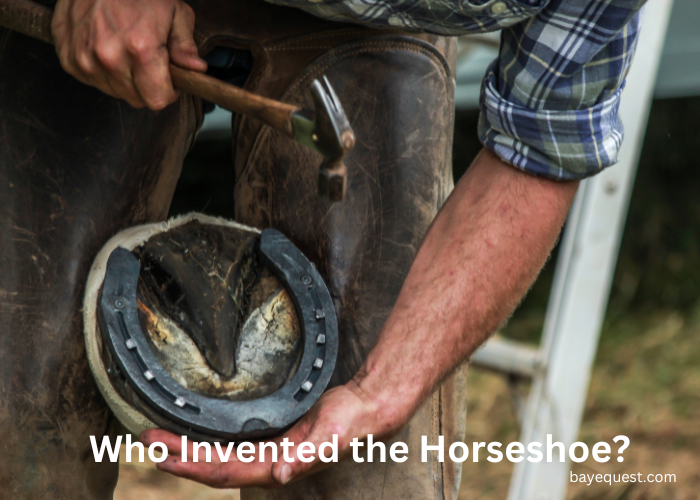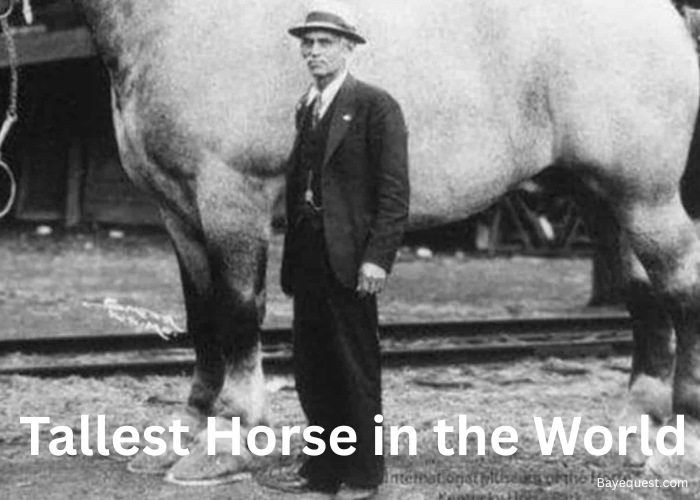Who would have thought that a simple piece of metal could change the course of history? The humble horseshoe, often overlooked, has been a silent hero in the world of travel, trade, and warfare.
It’s not just about protecting a horse’s hoof—it’s about how one small invention became a game-changer. But who had the bright idea to nail metal onto a horse’s foot? And why?
Let’s dig into the story of this ingenious invention and find out who first thought to give horses some extra grip.
Who Invented the Horseshoe? Key Takeaway
Who invented the horseshoe is not definitively known, but it is widely believed that the Romans were the first to use them. Evidence from the 1st century BC mentions a mule losing its shoe. Earlier versions by Asian horsemen used leather and plant material, evolving into metal shoes over time.
Why Horses Need Shoes
Why do horses need shoes? It’s a great question, especially when you think about how they live and work. Just like us, horses need a little extra support, depending on what they’re up to.
First, consider the terrain. Wild horses can roam around and their hooves naturally wear down right from the surfaces they walk on.
But our domestic horses often walk on harder, rougher surfaces like concrete or rocky trails.
These unnatural surfaces can wear their hooves down too quickly or unevenly. Shoes act like a protective barrier, keeping their hooves in good shape no matter where they tread.
Then there’s the work horses do. Many horses carry loads, pull weights, or perform in sports. This extra stress on their legs and hooves can lead to injuries or wear that could be prevented.
Shoes provide the extra cushion and support they need to perform their best. For example, a racehorse has shoes designed to maximize speed and reduce impact, while a farm horse might have shoes that give them better traction for pulling.
Shoes also help manage or prevent hoof problems. Just like people might wear orthotics in their shoes for foot problems, some horses need specially designed shoes to correct or prevent hoof issues.
In summary, horses need shoes for protection, performance, and prevention. For more information, check out our article, “Why do Horses Need Horseshoes?”
The History of Horseshoeing
Back in ancient times, people didn’t use horseshoes like we today. Ancient civilizations (Egyptians and Greeks) had horses, but horseshoes weren’t on the scene yet.
These folks were clever, though; they cared a lot about their horses’ hooves. They’d use natural materials, maybe wrap the hooves in rawhide or plant material to protect them.
Then came the Romans, who took a step closer to what we’d recognize as a horseshoe. They had something called the “hipposandal”—it’s not exactly a shoe, more like a sandal for horse hooves.
These were made from metal and wrapped around the hoof, protecting it without being nailed on.
As we move into the Dark Ages, that’s when things start to look familiar. In Europe, we begin to see the first real horseshoes.
These were made of metal and were nailed onto the hooves. This was a big deal because it meant better protection against wear and tear from rough terrains.
These early horseshoes were pretty basic, just bent pieces of metal designed to fit around the hoof. But they did the trick, helping horses to be more durable for travel and work.
Interesting read: Are horse shoes painful for horses?
Who Made Horseshoes?
This is a simple question with a not-so-simple answer. This invention keeps our horses’ hooves safe and sound, but tracing who first came up with this idea takes us on a journey through history.
The story begins long before our modern times, in lands far and wide. Ancient Romans had something like it—they called it a “hipposandal.” But the horseshoe as we know it?
It came much later, likely crafted by European blacksmiths in the Dark Ages. These early horseshoes were simple, nailed onto hooves, and designed to last.
The horseshoe evolved as knights and their horses travelled across battlefields and rugged terrain. It had to be tough and reliable.
By the Medieval era, every village had a blacksmith hammering out horseshoes, each one helping horses travel safer and faster.
So, who exactly invented the horseshoe? It’s hard to pin down a single inventor.
Instead, it’s a piece of history shaped by many hands, improved over centuries of innovation. It’s a testament to human ingenuity and a reminder of our enduring partnership with horses.
When Were Horseshoes Invented?
Horseshoes were invented around the 1st century BC. The earliest known use is credited to the Romans, who began using metal shoes to protect their horses’ hooves.
Before this, Asian horsemen used materials like leather and plant fibers to create hoof coverings. These later evolved into the metal horseshoes we know today.
The Invention of the Modern Horseshoe
Alright, let’s talk about how we got to the modern horseshoe. It’s a bit like piecing together a puzzle from history.
After the Romans with their hipposandals, things really started to take shape during the Middle Ages in Europe.
Back then, horses were becoming super important. Not just for farming but for transport and warfare.
People needed their horses to be more durable to travel longer distances without getting hurt.
So, blacksmiths began to experiment. They started crafting metal shoes that could be nailed directly to the hooves. This was a game-changer.
These early horseshoes were pretty basic, just pieces of iron shaped to fit the hoof. But they did the job.
They protected the horse’s hooves from rocky paths, cold weather, and general wear and tear. This meant horses could go faster and work harder, which was crucial back then.
As time went on, these shoes got more sophisticated. Blacksmiths learned better ways to shape the metal and tailor the shoes to different needs.
Whether a horse pulled a plow, carried a knight, or raced, its shoes could be customized. This customization is what really marks the beginning of the modern horseshoe.
So, the invention of the modern horseshoe wasn’t overnight. It evolved, driven by necessity, craftsmanship, and a deepening understanding of horse care.
It’s a testament to how people and technology evolve together to meet the challenges of their time.
Read also: Do wild horses trim their hooves?
The Development and Spread of Horseshoeing
When we think about how horseshoeing spread and developed, it’s like watching a network of roads expanding across a map. After those early days in medieval Europe, when the nailed horseshoe became a hit, its use just kept growing.
As Europe’s kingdoms grew and their armies marched across continents, the need for durable horses became more crucial.
Knights and cavalry units depended on their horses for mobility and speed, making horseshoeing an essential skill. Blacksmiths became highly valued craftsmen in villages and towns, with their skills passed down and refined from one generation to the next.
As trade routes expanded, so did the technology of horseshoeing. Blacksmiths from different parts of Europe would exchange techniques and ideas.
The horseshoe designs improved, becoming more suited to different types of terrain and work. For instance, heavier shoes for draft horses pulling loads and lighter, more agile shoes for warhorses.
By the time of the Renaissance, horseshoeing was a well-established craft. It wasn’t just practical; it was an art.
The spread of this technology was also helped by books and prints that began to circulate, sharing knowledge far wider than before.
So, the development and spread of horseshoeing were about meeting a need. As societies grew and changed, so did the technology around horseshoeing, spreading through necessity, trade, and knowledge sharing.
Horse Shoe Types
There are different types of horseshoes. Let’s look at some of them:
Regular
These are your standard horseshoes, the kind most people picture when they think of a horseshoe. They’re made of metal and used to protect the horse’s hooves from wear and tear.
Regular horseshoes are versatile and can be used for a wide variety of activities, from casual riding to some types of competition. They’re shaped like a ‘U’ and have nail holes for attaching them to the hoof.
Rim
Rim horseshoes are a bit special because they have a raised outer edge. This design gives the horse extra traction, kind of like the treads on your sneakers.
They’re particularly useful for sports that require quick turns and stops, like barrel racing or jumping. The rim style helps prevent the horse from slipping, which is crucial during high-speed events.
Bar
Bar horseshoes are made with a solid piece of metal extending across the hoof’s back. This connects the two ends of the shoe.
This design provides extra support to the hoof and is often used for horses with hoof injuries or issues that affect the heel or the back of the foot. It helps to distribute weight more evenly, which can be a big relief for a horse with hoof problems.
Heart bar
These are therapeutic shoes with a heart-shaped bar that fits over the hoof’s frog. The heart bar helps distribute pressure across the entire hoof, not just the outer edges.
This is especially helpful for horses with conditions like laminitis. The hoof’s structure needs additional support to heal or remain stable in such a condition.
Egg bar
Shaped like an egg or an oval, egg bar horseshoes extend beyond the back of the hoof. This extra length provides more support to the back of the hoof and the leg, making them ideal for horses with tendon or ligament issues.
The design helps reduce strain on the lower leg by supporting the hoof more balanced.
Rubber
Rubber horseshoes are all about comfort and shock absorption. They’re softer than metal shoes and can reduce the impact on a horse’s legs when they’re walking on hard surfaces.
These shoes are great for horses with sensitive hooves or for those that need a little extra cushioning. They’re quieter than metal shoes, which is nice for urban areas or indoor arenas.
Glue on
Glue on horseshoes are a good alternative for horses that can’t tolerate nails due to hoof issues or sensitivities. Instead of being nailed on, these shoes are attached with a special adhesive.
This method is gentler on the hoof and can be a great option for horses with damaged hooves or for those recovering from injuries.
Hoof boots
Hoof boots are like removable horseshoes. They’re not for permanent wear but can be worn when a horse needs extra protection or cushioning.
Hoof boots are great for trail rides over rough terrain or for horses that only occasionally need shoes. They are flexible, come in various sizes and styles, and can be a practical choice for horse owners looking for a non-permanent solution.
Horseshoe Materials
Horseshoes are made of various materials, each with its own benefits and uses. The choice of material can greatly influence a horse’s comfort and functionality.
Let’s explore the common materials used for horseshoes and see how each one serves a specific purpose in the care and management of horses.
Rubber
Rubber horseshoes are all about cushioning and comfort. They’re softer than metal horseshoes and really good at absorbing shocks, making them ideal for horses that walk on hard surfaces or have sensitive feet.
Rubber shoes are also quieter, which is a bonus in urban settings or for police horses that work on city streets. They’re not as durable as metal shoes, so they might not be the best choice for every situation, but they’re top-notch for comfort and noise reduction.
Steel
Steel horseshoes are the traditional choice. They’re tough, durable, and can handle anything a horse’s life throws at them.
Steel shoes hold up well on rocky trails, muddy fields, or long days of work. They’re also very customizable, which means a farrier can shape and adjust them to fit just right.
For everyday durability and adaptability, steel is a solid go-to material.
Aluminium
Aluminium horseshoes are much lighter than steel. This makes them popular in racing, where speed and performance matter.
The lighter weight means less fatigue for the horse, which can make a big difference in high-speed sports. Aluminium shoes can be shaped easily, which is great for achieving a perfect fit.
However, they tend to wear out faster than steel, so they might need to be replaced more often.
Composite
Composite horseshoes are made from modern materials like plastics and synthetic fibers. They offer a great mix of durability and shock absorption.
These shoes are designed to mimic the natural flexing of a horse’s hoof, which promotes better hoof health and comfort. Composite shoes are also lighter than steel and more durable than rubber, making them versatile for horses.
FAQs
How often do horses need shoes?
Horses need new shoes every four to six weeks. This schedule can vary based on the horse’s activities, the terrain they work on, and how their hooves grow. Regular farrier visits are crucial to maintain the health and proper alignment of the horse’s hooves.
Read more on how often horses need new shoes in our other guide.
Is hot shoeing horses still common practice?
Yes, hot shoeing, where the farrier heats the horseshoe in a forge before shaping and fitting it to the horse’s hoof, is still common. This method allows for a precise fit and can help improve the overall health of the hoof by creating a better seal between the shoe and the hoof. Many farriers prefer hot shoeing for its advantages in custom fitting and securing the shoe.
Who is a farrier?
A farrier is a skilled professional specializing in equine hoof care. This includes trimming and balancing horses’ hooves and placing shoes on their hooves if needed. Farriers combine blacksmith skills with equine anatomy and physiology knowledge to care for horses’ feet.
Conclusion
As we’ve trotted through the history of horseshoes, it’s clear that no single genius can claim the invention of the horseshoe. Instead, it’s a testament to centuries of shared knowledge and innovation shaped by horse and rider needs.
From ancient paths to modern racetracks, horseshoes have protected our noble companions and helped carry civilizations forward.
So, the next time you hear the familiar clip-clop of a horse, remember it’s not just a sound. It echoes history, crafted by countless unsung artisans who have kept our equine friends running smoothly through time.








